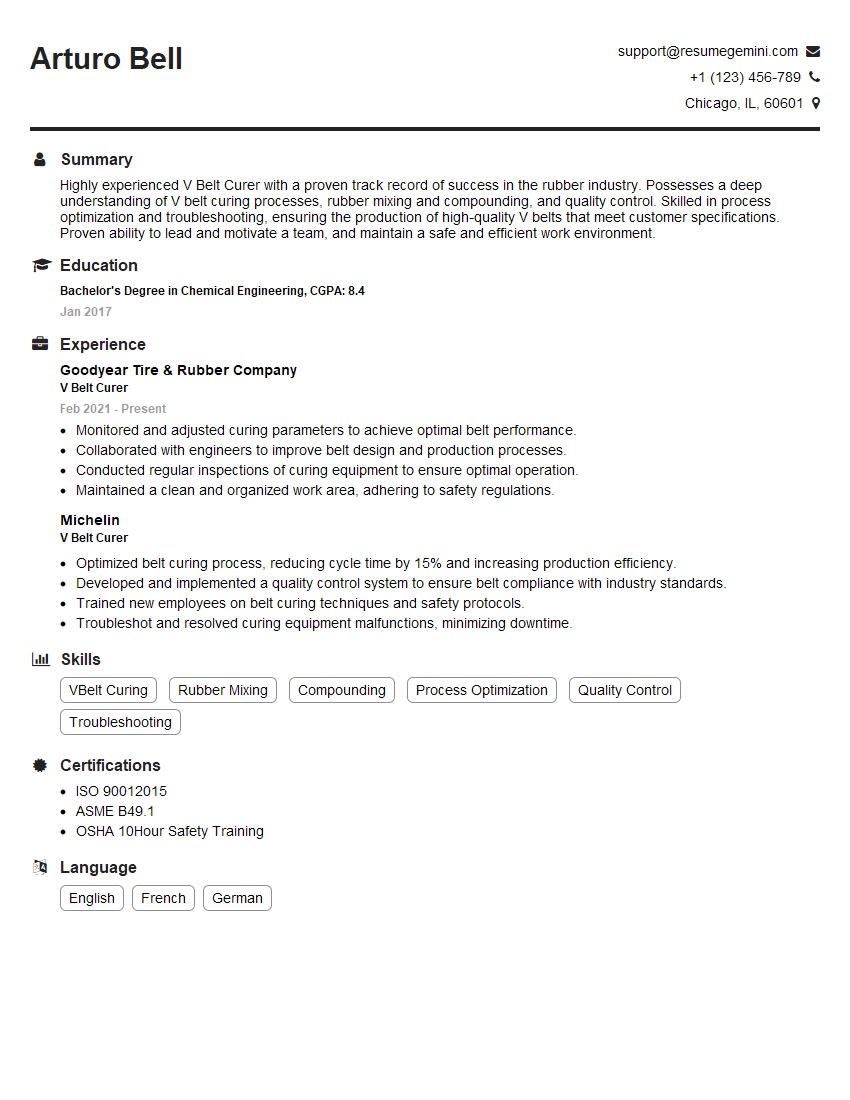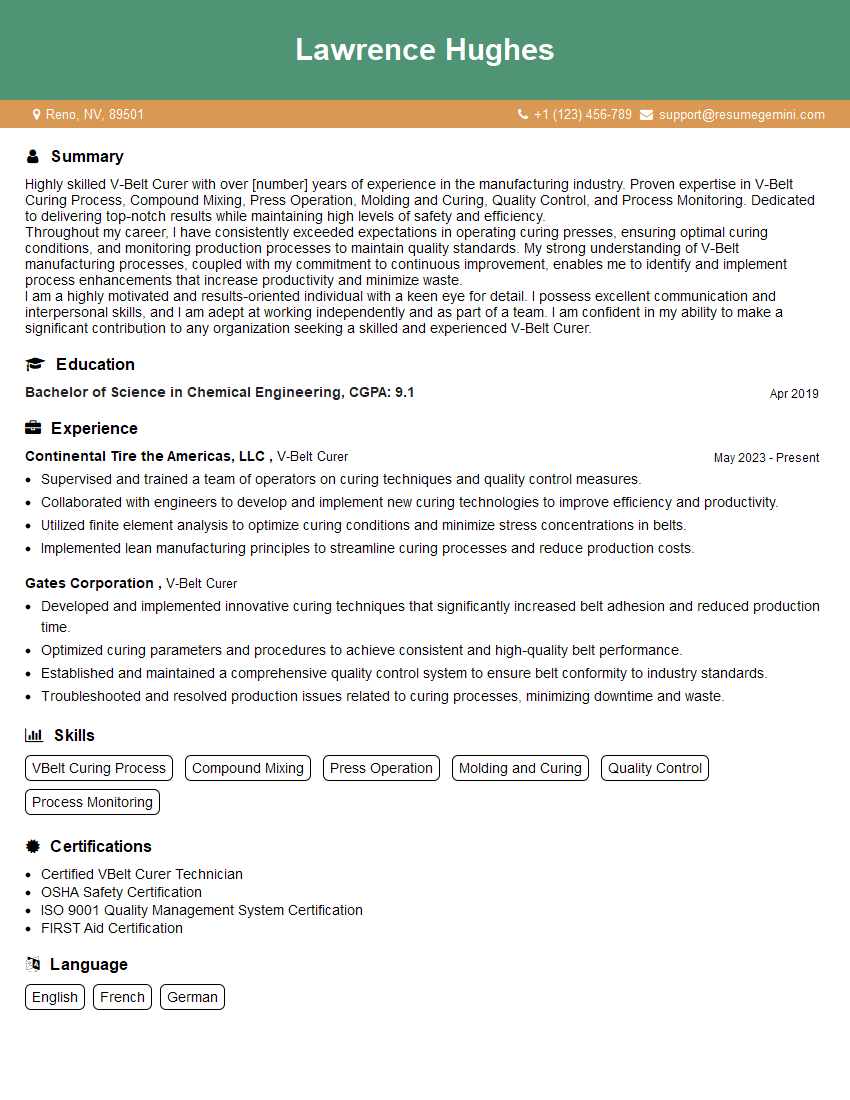Are you gearing up for an interview for a V Belt Curer position? Whether you’re a seasoned professional or just stepping into the role, understanding what’s expected can make all the difference. In this blog, we dive deep into the essential interview questions for V Belt Curer and break down the key responsibilities of the role. By exploring these insights, you’ll gain a clearer picture of what employers are looking for and how you can stand out. Read on to equip yourself with the knowledge and confidence needed to ace your next interview and land your dream job!
Acing the interview is crucial, but landing one requires a compelling resume that gets you noticed. Crafting a professional document that highlights your skills and experience is the first step toward interview success. ResumeGemini can help you build a standout resume that gets you called in for that dream job.
Essential Interview Questions For V Belt Curer
1. Explain the process of curing V belts.
The process of curing V belts involves several steps:
- Mixing and compounding: Raw materials, including rubber, fabric, and chemicals, are mixed to create the uncured V belt compound.
- Molding: The uncured compound is placed into a mold that shapes the belt’s profile and cross-section.
- Curing: The mold is placed in a curing press where it is subjected to heat and pressure. This process vulcanizes the rubber, forming strong cross-links between the rubber molecules, which imparts strength and elasticity to the belt.
- Trimming and finishing: Once cured, the belt is removed from the mold and trimmed to remove any excess material. It may also undergo additional finishing processes, such as surface treatment or grinding, to meet specific requirements.
2. What are the different types of curing processes used for V belts?
- Hot air curing: Belts are suspended in an oven or tunnel filled with hot air, which circulates around them to provide uniform heat distribution.
- Steam curing: Belts are placed in a pressure vessel filled with steam. Steam penetrates the belt, providing heat and moisture for vulcanization.
- Microwave curing: Microwaves are used to generate heat within the belt, accelerating the curing process.
- Radio frequency (RF) curing: RF energy is used to generate heat within the belt, similar to microwave curing.
3. What are the key factors to consider when selecting a curing process for V belts?
- Belt material: Different materials may require different curing temperatures and times.
- Belt size and shape: Larger belts may require longer curing times, and complex shapes may require specialized curing equipment.
- Production volume: High-volume production may require faster curing methods, such as microwave or RF curing.
- Equipment availability: The availability of curing equipment and the associated costs should be considered.
4. What are the common defects that can occur during V belt curing?
- Undercure: Insufficient curing time or temperature results in a belt that is weak and lacks proper strength.
- Overcure: Excessive curing time or temperature can cause the belt to become brittle and prone to cracking.
- Blowouts: Trapped air or moisture can expand during curing, causing bulges or ruptures in the belt.
- Surface defects: Scratches, dents, or contamination on the mold surface can transfer to the belt, affecting its appearance and performance.
5. How do you optimize the curing process for maximum belt performance and efficiency?
- Control temperature and time: Use accurate temperature sensors and timers to ensure consistent and optimal curing conditions.
- Monitor belt properties: Perform regular tests to ensure that cured belts meet specifications and exhibit the desired performance characteristics.
- Inspect equipment: Regularly inspect and maintain curing presses, molds, and other equipment to prevent defects and maintain efficiency.
- Train operators: Ensure that operators are properly trained on curing techniques and the identification of potential problems.
6. Describe the testing procedures used to evaluate the quality of cured V belts.
- Tensile strength test: Measures the belt’s resistance to breaking under tension.
- Elongation at break test: Determines the belt’s flexibility and ability to stretch before breaking.
- Hardness test: Evaluates the belt’s resistance to indentation or deformation.
- Dimensional inspection: Ensures that the belt meets the specified dimensions and tolerances.
- Visual inspection: Examines the belt for any surface defects, imperfections, or signs of damage.
7. Can you explain the importance of proper handling and storage of V belts?
- Avoid excessive heat: High temperatures can damage the rubber and shorten belt life.
- Protect from sunlight: UV exposure can cause the rubber to deteriorate.
- Store in a clean and dry place: Moisture and dirt can contaminate the belt and affect its performance.
- Handle with care: Rough handling can damage the belt’s surface or internal structure.
- Follow manufacturer’s recommendations: Each manufacturer may have specific handling and storage guidelines to ensure optimal belt life.
8. How can you troubleshoot common V belt problems encountered by customers?
- Slipping: Check for worn or glazed pulleys, misaligned belts, or excessive belt tension.
- Noise: Listen for squealing or grinding sounds, which may indicate pulley misalignment, worn bearings, or damaged belts.
- Breaking: Inspect the belt for cracks, cuts, or excessive wear. Check for any obstructions or foreign objects that could cause damage.
- Stretching: Measure the belt length and compare it to the original specifications. If the belt has stretched significantly, it may need to be replaced.
9. What are the latest advancements in V belt curing technology?
- High-frequency induction curing: Uses high-frequency electromagnetic waves to generate heat within the belt, offering faster and more efficient curing.
- Computerized process control: Integrates sensors and software to monitor and control curing parameters in real-time, ensuring consistent and optimized results.
- Green curing techniques: Explores environmentally friendly methods to reduce emissions and energy consumption during curing.
10. How do you stay updated with the latest developments in the V belt industry?
- Attend industry conferences and exhibitions: Network with professionals and learn about new technologies and trends.
- Read industry publications and technical journals: Stay informed about research and advancements in V belt manufacturing.
- Collaborate with manufacturers and suppliers: Seek information and support from industry experts.
- Conduct research and experimentation: Actively explore new ideas and methods to improve curing processes and belt performance.
Interviewers often ask about specific skills and experiences. With ResumeGemini‘s customizable templates, you can tailor your resume to showcase the skills most relevant to the position, making a powerful first impression. Also check out Resume Template specially tailored for V Belt Curer.
Career Expert Tips:
- Ace those interviews! Prepare effectively by reviewing the Top 50 Most Common Interview Questions on ResumeGemini.
- Navigate your job search with confidence! Explore a wide range of Career Tips on ResumeGemini. Learn about common challenges and recommendations to overcome them.
- Craft the perfect resume! Master the Art of Resume Writing with ResumeGemini’s guide. Showcase your unique qualifications and achievements effectively.
- Great Savings With New Year Deals and Discounts! In 2025, boost your job search and build your dream resume with ResumeGemini’s ATS optimized templates.
Researching the company and tailoring your answers is essential. Once you have a clear understanding of the V Belt Curer‘s requirements, you can use ResumeGemini to adjust your resume to perfectly match the job description.
Key Job Responsibilities
A V Belt Curer is responsible for operating, monitoring, maintaining, and repairing V-belt curing presses. The primary objective of this role is to ensure the production of high-quality V-belts that meet the specifications and standards required by the company.
1. Press Operation
The V Belt Curer is responsible for the proper operation of the V-belt curing presses. This includes:
- Loading and unloading the press with raw materials and finished products
- Monitoring the press temperature and pressure to ensure proper curing
- Adjusting the press settings to optimize the curing process
- Maintaining a clean and safe work area around the press
2. Product Quality Control
The V Belt Curer is responsible for ensuring the quality of the V-belts produced. This includes:
- Inspecting the V-belts for defects
- Testing the V-belts to ensure they meet the required specifications
- Maintaining records of the quality control tests
- Identifying and correcting any quality issues
3. Equipment Maintenance
The V Belt Curer is responsible for maintaining the V-belt curing presses. This includes:
- Performing regular maintenance checks
- Identifying and repairing any mechanical or electrical problems
- Ordering and replacing parts as needed
- Keeping a maintenance log to document all maintenance activities
4. Safety
The V Belt Curer is responsible for maintaining a safe work environment. This includes:
- Following all safety procedures
- Wearing appropriate personal protective equipment
- Identifying and reporting any safety hazards
- Participating in safety training programs
Interview Tips
To ace an interview for a V Belt Curer position, it is important to prepare thoroughly and demonstrate your skills and experience. Here are some tips:
1. Research the Company and Position
Before the interview, take some time to research the company and the specific V Belt Curer position. This will help you understand the company’s culture, values, and expectations for the role. You should also familiarize yourself with the job description and identify the key skills and experience that the company is looking for.
2. Practice Answering Common Interview Questions
There are a number of common interview questions that you are likely to be asked, such as “Tell me about yourself” and “Why are you interested in this position?”. It is helpful to practice answering these questions in advance so that you can deliver clear and concise responses. You can also prepare for specific questions related to the V Belt Curer position, such as “What experience do you have with operating V-belt curing presses?”.
3. Highlight Your Skills and Experience
During the interview, be sure to highlight your skills and experience that are relevant to the V Belt Curer position. For example, you can discuss your experience with operating V-belt curing presses, your knowledge of product quality control, and your ability to maintain equipment. You can also mention any safety training or certifications that you have.
4. Ask Questions
At the end of the interview, be sure to ask questions of your own. This shows that you are interested in the position and that you are taking the interview seriously. You can ask questions about the company, the position, or the industry. Asking questions also gives you an opportunity to learn more about the company and to determine if it is a good fit for you.
Next Step:
Armed with this knowledge, you’re now well-equipped to tackle the V Belt Curer interview with confidence. Remember, preparation is key. So, start crafting your resume, highlighting your relevant skills and experiences. Don’t be afraid to tailor your application to each specific job posting. With the right approach and a bit of practice, you’ll be well on your way to landing your dream job. Build your resume now from scratch or optimize your existing resume with ResumeGemini. Wish you luck in your career journey!

